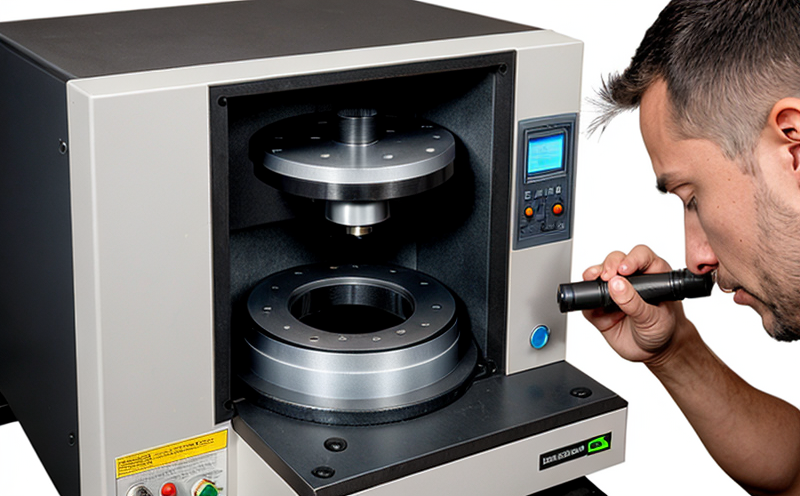ASTM E10 Brinell Hardness with Microstructure Examination
The ASTM E10 standard defines a method to measure the hardness of metallic materials using the Brinell scale. This test is particularly useful for assessing the mechanical properties and microstructural integrity of various metals, especially in the context of additive manufacturing (AM) where the quality control process plays a critical role.
Microstructure examination complements Brinell hardness testing by providing insight into the internal structure and grain size distribution within the material. Understanding these characteristics is vital for ensuring that the mechanical properties are consistent and meet specified standards, especially in sectors like aerospace, automotive, and manufacturing where component reliability is paramount.
The ASTM E10 Brinell Hardness test with microstructure examination involves several key steps:
- Specimen Preparation: The specimen must be carefully prepared to ensure an accurate and repeatable test. This includes removing any surface contamination or irregularities that could affect the results.
- Test Setup: A Brinell hardness tester is used, which applies a specified load (measured in kilograms-force) for a specific duration using a defined tungsten carbide ball indenter of 10 mm diameter. The depth of the indentation is then measured to calculate the Brinell Hardness Number (HB).
- Microstructure Examination: Once the hardness test is completed, the sample is sectioned and polished for microstructural analysis using techniques such as optical microscopy or scanning electron microscopy (SEM). This allows us to observe grain size, phase distribution, and any internal defects.
The combination of these tests provides a comprehensive understanding of both the mechanical properties and the microstructure of the material. This is particularly important in additive manufacturing where layer-by-layer deposition can lead to variations in the final product's structure and performance.
For instance, in aerospace applications, ensuring that the metal parts have consistent hardness across all layers is critical for preventing failure under stress. In automotive components, this test ensures durability and longevity of the materials used in high-stress environments. Similarly, in manufacturing, it helps to maintain quality control standards by verifying that each batch meets the required specifications.
The ASTM E10 Brinell Hardness with Microstructure Examination is not just a routine test; it's an essential tool for ensuring product integrity and compliance with industry standards. By combining mechanical testing with microstructural analysis, we can provide detailed insights into the material properties that are crucial for quality assurance.
Benefits
The ASTM E10 Brinell Hardness test with microstructure examination offers several key benefits:
- Enhanced Quality Control: By measuring hardness and examining the microstructure, we can identify any inconsistencies in the manufacturing process.
- Better Understanding of Material Properties: The combination of mechanical testing with microstructural analysis provides a more comprehensive picture of the material's properties.
- Improved Product Reliability: Ensuring consistent hardness and microstructure helps to prevent failures due to stress or wear in critical components.
- Compliance with Standards: This test ensures that materials meet the required standards, which is essential for maintaining industry reputation.
The results of this testing can be used to improve manufacturing processes and ensure product reliability. For quality managers, compliance officers, and R&D engineers, it provides critical data that informs decision-making and process optimization.
Eurolab Advantages
At Eurolab, we offer a range of advantages when it comes to performing the ASTM E10 Brinell Hardness with Microstructure Examination:
- Accurate and Reliable Results: Our state-of-the-art equipment and experienced staff ensure that every test is performed accurately and reliably.
- Comprehensive Reporting: We provide detailed reports that include both the Brinell hardness values and microstructural analysis findings, ensuring a complete picture of the material properties.
- Expertise in Additive Manufacturing: Our team has extensive experience in testing materials used in AM processes, providing insights specific to this sector.
- Compliance with International Standards: We adhere strictly to international standards such as ASTM E10 and ISO standards for quality assurance.
Our commitment to excellence ensures that every test is conducted to the highest standards, providing you with confidence in the results and peace of mind regarding compliance.
Customer Impact and Satisfaction
The ASTM E10 Brinell Hardness with Microstructure Examination has a significant impact on our customers:
- Enhanced Product Quality: By ensuring that materials meet the required standards, we help improve product quality and reliability.
- Improved Process Efficiency: Our testing services allow for the identification of process issues early on, leading to more efficient manufacturing processes.
- Increased Customer Satisfaction: Consistent high-quality products lead to higher customer satisfaction and loyalty.
We have a track record of delivering accurate and reliable results that meet or exceed customer expectations. Our customers trust us to provide the insights needed for informed decision-making, ensuring they can deliver top-tier products to their own customers.





